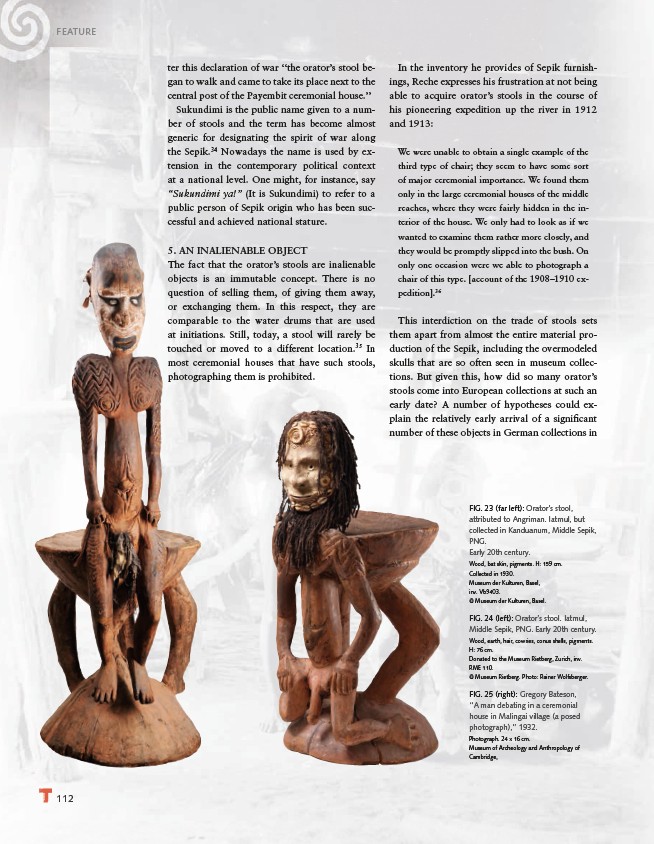
FEATURE
112
ter this declaration of war “the orator’s stool began
to walk and came to take its place next to the
central post of the Payembit ceremonial house.”
Sukundimi is the public name given to a number
of stools and the term has become almost
generic for designating the spirit of war along
the Sepik.34 Nowadays the name is used by extension
in the contemporary political context
at a national level. One might, for instance, say
“Sukundimi ya!” (It is Sukundimi) to refer to a
public person of Sepik origin who has been successful
and achieved national stature.
5. AN INALIENABLE OBJECT
The fact that the orator’s stools are inalienable
objects is an immutable concept. There is no
question of selling them, of giving them away,
or exchanging them. In this respect, they are
comparable to the water drums that are used
at initiations. Still, today, a stool will rarely be
touched or moved to a different location.35 In
most ceremonial houses that have such stools,
photographing them is prohibited.
In the inventory he provides of Sepik furnishings,
Reche expresses his frustration at not being
able to acquire orator’s stools in the course of
his pioneering expedition up the river in 1912
and 1913:
We were unable to obtain a single example of the
third type of chair; they seem to have some sort
of major ceremonial importance. We found them
only in the large ceremonial houses of the middle
reaches, where they were fairly hidden in the interior
of the house. We only had to look as if we
wanted to examine them rather more closely, and
they would be promptly slipped into the bush. On
only one occasion were we able to photograph a
chair of this type. account of the 1908–1910 expedition.
FIG. 23 (far left): Orator’s stool,
attributed to Angriman. Iatmul, but
collected in Kanduanum, Middle Sepik,
PNG.
Early 20th century.
Wood, bat skin, pigments. H: 159 cm.
Collected in 1930.
Museum der Kulturen, Basel,
inv. Vb9403.
© Museum der Kulturen, Basel.
FIG. 24 (left): Orator’s stool. Iatmul,
Middle Sepik, PNG. Early 20th century.
Wood, earth, hair, cowries, conus shells, pigments.
H: 76 cm.
Donated to the Museum Rietberg, Zurich, inv.
RME 110.
© Museum Rietberg. Photo: Rainer Wolfsberger.
FIG. 25 (right): Gregory Bateson,
“A man debating in a ceremonial
house in Malingai village (a posed
photograph),” 1932.
Photograph. 24 x 16 cm.
Museum of Archeology and Anthropology of
Cambridge,
36
This interdiction on the trade of stools sets
them apart from almost the entire material production
of the Sepik, including the overmodeled
skulls that are so often seen in museum collections.
But given this, how did so many orator’s
stools come into European collections at such an
early date? A number of hypotheses could explain
the relatively early arrival of a signifi cant
number of these objects in German collections in